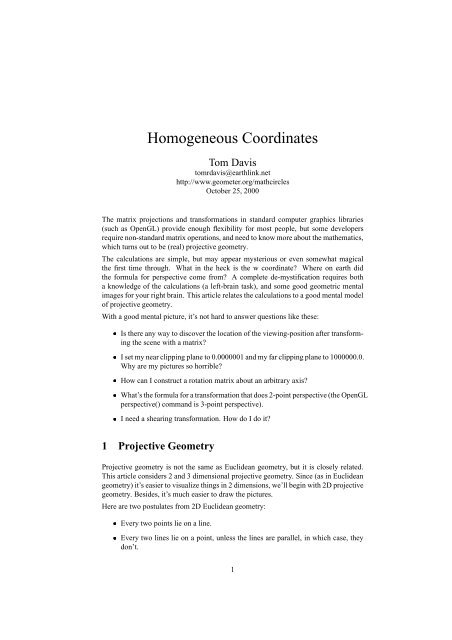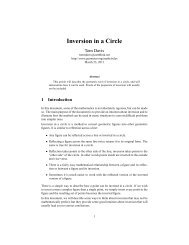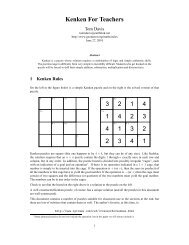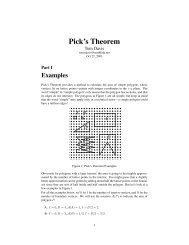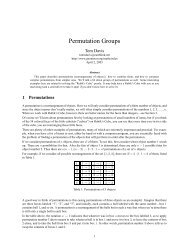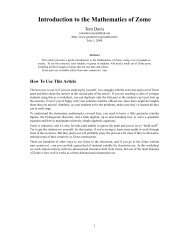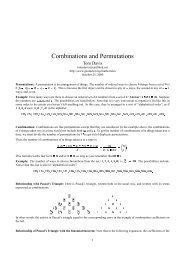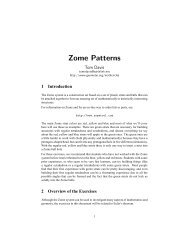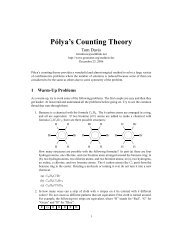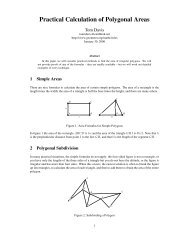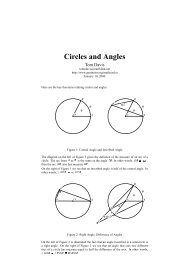Homogeneous Coordinates - Home Page -- Tom Davis
Homogeneous Coordinates - Home Page -- Tom Davis
Homogeneous Coordinates - Home Page -- Tom Davis
You also want an ePaper? Increase the reach of your titles
YUMPU automatically turns print PDFs into web optimized ePapers that Google loves.
<strong>Homogeneous</strong> <strong>Coordinates</strong><br />
<strong>Tom</strong> <strong>Davis</strong><br />
tomrdavis@earthlink.net<br />
http://www.geometer.org/mathcircles<br />
October 25, 2000<br />
The matrix projections and transformations in standard computer graphics libraries<br />
(such as OpenGL) provide enough flexibility for most people, but some developers<br />
require non-standard matrix operations, and need to know more about the mathematics,<br />
which turns out to be (real) projective geometry.<br />
The calculations are simple, but may appear mysterious or even somewhat magical<br />
the first time through. What in the heck is the w coordinate? Where on earth did<br />
the formula for perspective come from? A complete de-mystification requires both<br />
a knowledge of the calculations (a left-brain task), and some good geometric mental<br />
images for your right brain. This article relates the calculations to a good mental model<br />
of projective geometry.<br />
With a good mental picture, it’s not hard to answer questions like these:<br />
Is there any way to discover the location of the viewing-position after transforming<br />
the scene with a matrix?<br />
I set my near clipping plane to 0.0000001 and my far clipping plane to 1000000.0.<br />
Why are my pictures so horrible?<br />
How can I construct a rotation matrix about an arbitrary axis?<br />
What’s the formula for a transformation that does 2-point perspective (the OpenGL<br />
perspective() command is 3-point perspective).<br />
I need a shearing transformation. How do I do it?<br />
1 Projective Geometry<br />
Projective geometry is not the same as Euclidean geometry, but it is closely related.<br />
This article considers 2 and 3 dimensional projective geometry. Since (as in Euclidean<br />
geometry) it’s easier to visualize things in 2 dimensions, we’ll begin with 2D projective<br />
geometry. Besides, it’s much easier to draw the pictures.<br />
Here are two postulates from 2D Euclidean geometry:<br />
Every two points lie on a line.<br />
Every two lines lie on a point, unless the lines are parallel, in which case, they<br />
don’t.<br />
1
In 2D projective geometry, they are replaced by:<br />
Every two points lie on a line.<br />
¡<br />
Every two lines lie on a point.<br />
¡<br />
That’s basically the whole difference. How can we visualize a model for such a thing?<br />
The model must describe all the points, all the lines, what points are on what lines, and<br />
so on.<br />
The easiest way is to take the points and lines from a standard 2D Euclidean plane<br />
and add stuff until the projective postulates are satisfied. The first problem is that the<br />
parallel lines don’t meet. Lines that are almost parallel meet way out in the direction<br />
of the lines, so for parallel lines, add a single point for each possible direction and add<br />
it to all the parallel lines going that way. You can think of these points as being points<br />
at infinity—at the “ends” of the lines. Note that each line includes a single point at<br />
infinity—the north-south line doesn’t have both a north and south point at infinity. If<br />
you “go to infinity” to the north and keep going, you will find yourself looping around<br />
from the south. Projective lines form loops.<br />
Now take all the new points at infinity and add a single line at infinity going through all<br />
of them. It, too, forms a loop that can be imagined to wrap around the whole original<br />
Euclidean plane. These points and lines make up the projective plane.<br />
You might make a mental picture as follows. For some small configuration of points<br />
and lines that you are considering, imagine a really large circle centered around them,<br />
so large that the part of the figure of interest is like a dot in its center. Now any parallel<br />
lines that go through that “dot” will hit the large circle very close together, at a point<br />
that depends only on their direction. Just imagine that all parallel lines hit the circle at<br />
that point. That is the “line at infinity”.<br />
Check the postulates. Two points in the Euclidean plane still determine a single projective<br />
line. One point in the plane and a point at infinity determine the projective line<br />
through the point and going in the given direction. Finally, the line at infinity passes<br />
through any two points at infinity.<br />
How about lines? Two non-parallel lines in the Euclidean plane still meet in a point,<br />
and parallel lines have the same direction, so meet at the point at infinity in that direction.<br />
Every line on the original plane meets the line at infinity at the point at infinity<br />
corresponding to the line’s direction.<br />
Note: The projective postulates do not distinguish between points and lines in the sense<br />
that if you saw them written in a foreign language:<br />
Every two glorphs lie on a smynx,<br />
¡<br />
Every two smynxes lie on a glorph,<br />
¡<br />
there is no way to figure out whether a smynx is a line and a glorph is a point or viceversa.<br />
If you take any theorem in 2D projective geometry and replace “point” with<br />
“line” and “line” with “point”, it makes a new theorem that is also true. This is called<br />
“duality”—see any text on projective geometry.<br />
2
2 <strong>Homogeneous</strong> <strong>Coordinates</strong><br />
So we’ve got a nice mental picture—how do we assign coordinates and calculate with<br />
it? The answer is that every triple of real numbers ¢£¥¤ ¦§¤¨© except ¢ ¤ ¤ © corresponds<br />
to a projective point. If ¨ is non-zero, ¢£¤¦§¤ ¨© corresponds to the point<br />
¢£§ ¨¤¦ ¨©<br />
in the original Euclidean plane; ¢£¤¦§¤ © corresponds to the point at infinity<br />
corresponding to the direction of the line passing through ¢ ¤ © and ¢£¤¦ © .<br />
Generally, if is any non-zero number, the homogeneous coordinates ¢£¤¦§¤ ¨© and<br />
¢ £¤ ¦§¤ ¨©<br />
represent the same point.<br />
It’s a bit disturbing that the same projective point can be represented in many different<br />
ways. For example, ¢ ¤ ¤ © , ¢ ¤¤ © , and ¢ ¤ ¤ © all refer to the Euclidean<br />
point ¢ ¤ © . Don’t panic, however; you’ve seen the same kind of thing before in third<br />
grade—the fractions , , and <br />
all represent the same number. Just as we<br />
usually use the fraction reduced to lowest terms, we usually use projective coordinates<br />
with w equal to when that’s possible.<br />
Since projective points and lines are in some sense indistinguishable, it had better be<br />
possible to give line coordinates as sets of three numbers (with at least one non-zero). If<br />
the points are row vectors (as in the OpenGL), the lines will be column vectors (written<br />
with a “ ” exponent that represents “transpose”), so ¢¤ ¤ © represents a line. The<br />
point ¢£¤¦§¤ ¨©<br />
lies on the line !" ¢¤ ¤ ©<br />
if £$#% ¦&#' ¨ <br />
. In the<br />
Euclidean plane, the point ¢£¥¤ ¦ © can be written in projective coordinates as ¢£¥¤ ¦§¤ © ,<br />
so the condition becomes £$#% ¦&#' <br />
—high-school algebra’s equation for a<br />
line. The line passing through all the points at infinity has coordinates ¢ ¤ ¤ © .<br />
As with points, for any non-zero , the line coordinates ¢¤ ¤ © and ¢ ¤ ¤ ©<br />
represent the same line.<br />
In matrix notation, the point lies on the line! if and only if(!) <br />
. If we had<br />
chosen to represent lines as column vectors and points as row vectors, that would work<br />
fine, too. It has to work because points and lines are dual concepts.<br />
3 Projective Transformations<br />
Projective transformations transform (projective) points to points and (projective) lines<br />
to lines such that incidence is preserved. In other words, if is a projective transformation<br />
and points and* lie on line! then+(, and+*, lie on+!-, . Similarly,<br />
if lines! and. meet at point , then the lines+!/, and+.', meet at the point<br />
+(, .<br />
The reason projective transformations are so interesting is that if we use the model<br />
of the projective plane described above where we’ve simply added some stuff to the<br />
Euclidean plane, the projective transformations restriced to the Euclidean plane include<br />
all rotations, translations, non-zero scales, and shearing operations. This would be<br />
powerful enough, but if we don’t restrict the transformations to the Euclidean plane,<br />
the projective transformations also include the standard projections, including the very<br />
important perspective projection.<br />
3
J1 L 1 L K M DP>RQ =<br />
Rotation, translation, scaling, shearing (and all combinations of them) map the line at<br />
infinity to itself, although the points on that line may be mapped to other points at infinity.<br />
For example, a rotation of 5 degrees maps each point at infinity corresponding to a<br />
direction to the point corresponding to the direction rotated 5 degrees. Pure translations<br />
preserve the directions, so a translation maps each point at infinity to itself.<br />
The standard perspective transformation (with a0 1 2 field of view, the eye at the origin,<br />
and looking down the3 -axis) maps the origin to the point at infinity in the3 -direction.<br />
The viewing trapezoid maps to a square.<br />
Every non-singular46574 matrix (non-singular means that the matrix has an inverse)<br />
represents a projective transformation, and every projective transformation is represented<br />
by a non-singular45$4 matrix. If8 is such a transformation matrix and9 is<br />
a projective point, then98 is the transformed point. If: is a line,8"1 , so<br />
98'8A1 , soB9(8'C B8A1 . The matrix representation is not unique—as<br />
with points and lines, any constant multiple of a matrix represents the same projective<br />
transformation.<br />
Combinations of transformations are represented by products of matrices; a rotation<br />
represented by matrix D followed by a translation (matrix E ) is represented by the<br />
matrixDE .<br />
A (2D) projective transformation is completely determined if you know the images of 4<br />
independent points (or of 4 independent lines). This is easy to see, since a4(5F4 matrix<br />
has nine numbers in it, but since any constant multiple represents the same transformation,<br />
there are basically 8 degrees of freedom. Each point transformation that you lock<br />
down eliminates 2 degrees of freedom, so the images of 4 points completely determine<br />
the transformation.<br />
Let’s look at a simple example of how this can be used by deriving from scratch the<br />
rotation matrix for aG H 2 rotation about the origin. The origin maps to itself, the points<br />
at infinity along theI and3 axes map to points at infinity rotatedG H 2 , and the point<br />
JK L K M<br />
maps to J 1 L N O M<br />
. See figure 4<br />
IfD is the unknown matrix:<br />
J1 L 1 L K M<br />
JK L 1 L 1 M DP>RQ S JN O L N O L 1 M<br />
L K L 1 M DP>RQ T JU N O L N O L 1 M<br />
JK L K L K M<br />
J1<br />
V J1 L N O L K M DP>RQ<br />
W W W§L Q V can be any constants since any multiple of a projective point’s coordinates<br />
represents the same projective 8 point. has basically 8 unknowns, so those<br />
L<br />
8 plus 4Q X the ’s make 12. Each matrix equation represents 3 equations, so there is a<br />
system of 12 equations and 12 unknowns that can be solved. The computations may<br />
=<br />
TheQ<br />
be ugly, but it’s a straight-forward brute-force solution that gives the rotation matrix as<br />
4
hg<br />
hg<br />
any multiple of:<br />
[\^] _ ` _a] _ ` _cb<br />
There’s nothing special about rotation. Every projective transformation matrix can be<br />
determined in the same brute-force manner starting from the images of 4 independent<br />
points.<br />
We illustrate with the determination of the (2D) perspective transformation (see figure<br />
3). We want to map the shaded trapezoidal area into the square cornersid<br />
e j d e k<br />
with<br />
andie j e k<br />
. The unknown projection must satisfy:<br />
Y%Z<br />
d ] _ ` _ ] _ ` _cb<br />
bfe<br />
j b j e k l ZRm n ib j e j b k ib<br />
jo/j e k l ZRm p ib j d e j e k ib<br />
j q j e k l ZRm r id e j e j e k iq<br />
j b j b k l ZRm s ie j b j b k ie<br />
The same brute-force calculation gives as (any multiple of):<br />
l<br />
l Z<br />
b b<br />
b<br />
[\e<br />
o¥v ` tq d o¥v d e<br />
bw_ q o` tq d o¥vxb d(tqFu<br />
Three Dimensional Projective Space<br />
3D projective space has a similar model. Take 3D Euclidean space, add points at<br />
infinity in every 3-dimensional direction, and add a plane at infinity going through the<br />
points. In this case there will also be an infinite number of lines at infinity as well. In<br />
3D, points and planes are dual objects.<br />
Projective transformations in 3 dimensions are exactly analogous. Points are represenated<br />
4-tuple row vectors: iy j z§j {j|k<br />
, and planes by column vectors: i} j ~ j j € k<br />
. Any<br />
multiple of a point’s coordinates represents the same projective point. A point l lies<br />
on a plane‚ if l ‚ Z b<br />
. All 3D projective transformations are represented byƒF„6ƒ<br />
non-singular matrices.<br />
In 3 dimensions, the images of 5 points (or planes) completely determine a projective<br />
transformation. (Aƒ6„…ƒ matrix has 16 numbers, but 15 degrees of freedom because<br />
any multiple represents the same transformation. Each point transformation that you<br />
nail down eliminates 3 degrees of freedom, so the images of 5 independent points<br />
completely determine the transformation.)<br />
The brute-force solution has 20 equations and 20 unknowns (there will be 5m †<br />
’s in addition<br />
to the 15 unknowns), and although the solution is time-consuming, it is straightforward.<br />
The calculation can be simplified. Suppose you want a transformation that takes l n<br />
to<br />
5
‡ˆ<br />
, ..., and‰¥Š to ‡ Š . Let ‹<br />
‹<br />
‹<br />
‹<br />
ˆ ŒPŽ ‘ ‘ ‘ ’<br />
‹ “<br />
‹ ”<br />
ŒPŽ‘ ‘ ‘ ’<br />
Find the transformation P that takes‰– to<br />
ŒPŽ ’ Š<br />
and the transformation Q that takes‡<br />
– to<br />
–<br />
– . Because of all the zeroes, these are much easier to work out. The transformation<br />
‹ •<br />
ŒPŽ‘ ‘ ‘ ’<br />
ŒPŽ‘ ‘ ‘ ’<br />
you want is‰<br />
‡— ˆ<br />
.<br />
4 Using the Mental Model<br />
Let’s conclude by taking another look at the questions from the first section.<br />
Perspective projections map the eye point to infinity, so if you know the projection<br />
matrix and want to find the eye point, find the point that maps via the projection to<br />
infinity in the˜ -direction.<br />
If you’re wondering about the bizarre effects of widely spaced near and far clipping<br />
planes, look at how much streching occurs between the origin and .0000001.<br />
Construction of the three projections is simply a matter of listing 5 independent points<br />
and their images and calculating the matrix by brute force.<br />
The more ways you have to look at a mathematical concept, the better you will understand<br />
it. Perhaps the mental images here may provide you with some additional<br />
insight.<br />
6


